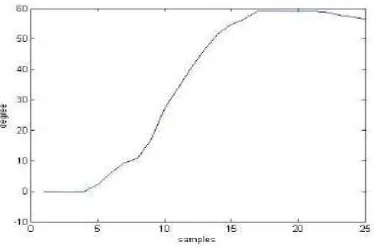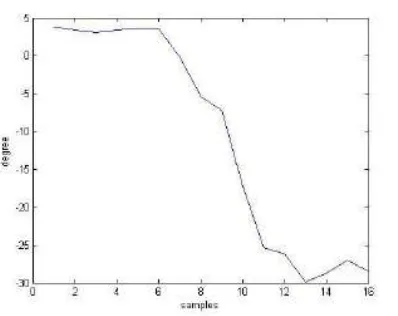International Research Journal of Engineering and Technology (IRJET) e-ISSN: 2395-0056
Volume: 06 Issue: 05 | May 2019 www.irjet.net p-ISSN: 2395-0072© 2019, IRJET | Impact Factor value: 7.211 | ISO 9001:2008 Certified Journal | Page 7967
Wrist Motion Detector cum Efficiency
Evaluator
Sanzitha K
1, Priya S
2, Angelin Maria
3, Bindhya Boban P B
4, Teena Rajan
51,2,3,4,5
Department of Electronics and Communication Engineering, Mar Baselios College of Engineering and
Technology, Nalanchira, Trivandrum, Kerala, India
---***---
Abstract: There are many types of sprains, fractures and dislocations that can happen at various joints present in our body. One of the most important joint is the wrist joint. The crucial functions of our hand is partly controlled by our wrists. Fractures occurring at the wrist are identified using advanced x-ray technologies and the Wrist Motion Detector cum Efficiency Evaluator project is developed as an add-on to this function. This proposed system is used to measure the range of motion of the wrist with which we can also check the efficiency of the treatment that is provided. It is basically a wrist wearable unit that consist of kinematic and temperature sensors that is used to sense the wrist movements in real time. A wireless access point is used to connect the hardware and software components of the project. The software platform that is used in this project is python.
Keywords: wrist wearable technology, treatment efficiency, real time data
I. INTRODUCTION
The human hand is an important part of the body that can perform many functions. We can do numerous activities like waving, getting a handle on, flexing, and so forth which makes our life simpler and better. The blend of portability and solidness, and their ability to move in various planes gives us a wide scope of movement. The gathering of bones and delicate tissues that associates the lower arm to the hand is called wrist or carpus. The capacity to handle, flex and expanding the fingers are influenced by the present position of the wrist.
This important part of the human hand is prone to injuries and dis-alignments due to the various activities performed. As a result of many kinds of fractures and dis-alignments occurring at the wrist, almost 20% of the bone fractures that are reported at the hospitals are wrist injuries. However, in India a country in which half of the population lives on places with little medical facilities, this proposed system can be used to confirm the type of fractures that occur at the small bones on the wrist which could only be detected by using advanced x-rays in high tech hospitals. As a matter of fact this proposed system can be used as an add-on to x-rays in the case of rural areas.
In addition to this, this system is also used after the operation, that is, at each stages of physiotherapy, this proposed system is used to measure the improvements in the range of motion of the wrist. As a result, this can be used to check how much efficient the provided treatment is.
The rest of the paper is organized as follows: Section II deals with related works, Section III is about the system design. The working of the system is also covered in this section. Section IV contains the simulation results. Finally the sixth section contains the summary and the conclusion and seventh section deals with the future developments of this proposed system.
II. RELATED WORKS
This section describes some of the related works carried out to find the range of motion of the wrist. [11]Hillevi Johansson, proposed a system “Smart sensor for wrist movements”, this system uses a cyber glove which is equipped with smart sensors to calculate the range of motion of the wrist.
In another work proposed by [12]Fatemeh Abyarjoo, “Monitoring Human Wrist Rotation in Three Degrees of Freedom”, a research was carried out to monitor the wrist movements using accelerometer and magnetometer sensors.
[1] Liang-bi Chen in his work “WristEye: Wearable Devices and a System for Supporting Elderly Computer Learners”, used the wrist movements to help the elderly to learn the computer by monitoring the wrist movements.
III. SYSTEM DESIGN
The proposed wrist motion detector system is used to capture the real time monitoring of wrist alignment using various parameters like flexion, extension, ulnar and radial deviation, pitch and roll etc.
International Research Journal of Engineering and Technology (IRJET) e-ISSN: 2395-0056
Volume: 06 Issue: 05 | May 2019 www.irjet.net p-ISSN: 2395-0072 [image:2.612.86.230.456.659.2]© 2019, IRJET | Impact Factor value: 7.211 | ISO 9001:2008 Certified Journal | Page 7968
Fig 3.1: System architectureThe main objective of the project is to find the range of motion of the wrist. This is used before any treatment is provided and also after the treatment of the wrist, i.e after physiotherapy, so that we can find out how much the treatment was efficient. For this purpose we need a device that can sense the range of motion for that ADXL337 accelerometer com gyroscope is used. In the hardware part we place this accelerometer in such a way that we could get the motion of the wrist in three different planes, i.e x, y and z. The wrist movements like flexion, extension, supination and pronation is measured in terms of angles (degrees), for this a 3-axis accelerometer (ADXL337) with x, y and z coordinate system is implemented, for finding the actual range of motion we use the quantities roll, pitch and yaw with the formula:
The above formula gives angles φ in roll, θ in pitch and ψ in yaw about the x, y and z axes respectively.
This mathematical expression is derived with respect to the Earth’s gravitational constant ‘g’. After converting into linear expression we get the formula:
roll = ( ( (atan2(y_g_value,z_g_value) * 180) / 3.14 ) + 180 )
pitch = ( ( (atan2(z_g_value,x_g_value) * 180) / 3.14 ) + 18 0 )
yaw = ( ( (atan2(x_g_value,y_g_value) * 180) / 3.14 ) + 18 0 )
where x_g_value, y_g_value, z_g_value are the acceleration in the x, y and z plane with respect to the gravitational constant ‘g’ which is obtained by using this formula:
x_g_value = ( ( ((x_adc_value * 3.3)/1024) - 1.65 ) / 0.330 )
y_g_value = ( ( ((y_adc_value * 3.3)/1024) - 1.65 ) / 0.330 )
z_g_value = ( ( ((z_adc_value * 3.3)/1024) - 1.80 ) / 0.330 )
where x_adc_value, y_adc_value, z_adc_value are the digital value of voltage in the
x_out_pin, y_out_pin, z_out_pin in the accelerometer unit.Fu rther the values of roll, pitch and yaw obtained from the se nsor is compared with a look-up table obtained by a surv ey.
ROLL- Gives the pronation and supination movements of t he wrist.
PITCH- Gives the flexion and extension movements of the wrist.
YAW- Gives the radial and ulnar deviation of the wrist.
International Research Journal of Engineering and Technology (IRJET) e-ISSN: 2395-0056
Volume: 06 Issue: 05 | May 2019 www.irjet.net p-ISSN: 2395-0072© 2019, IRJET | Impact Factor value: 7.211 | ISO 9001:2008 Certified Journal | Page 7969
A
G
E
G
R
OUPS
(
YR
S)
RANGE OF MOTION (IN DEGREES)
FL
EX
ION
EX
TEN
SIO
N
R
A
DIA
L
DE
VIA
TIO
N
UL
N
A
R
DE
VIA
TIO
N
15 – 30 35- 40 35-45 25 30 - 15- 40
30
- 50 36-38 35-40 26– 28 25– 38
[image:3.612.55.273.82.327.2]
>50 36-37 36-40 26- 27 20 - 36
Table 1: Calibrated Range of Motion of Wrist.
Fig 3.2: Normal angles of wrist movement
The microcontroller used is Arduino UNO with ATMega 328p chip whose power supply is taken from a 5V usb charger. A temperature sensor is used to find the body temperature of the patient because after the injury in case if there is an inflammation in the wrist the temperature rises 2 to 3 degrees from the actual body temperature. Increase in temperature due to inflammation is a positive
sign as it indicates that the wound is healing. The temperature is measured in degree Celsius by using LM35 sensor. Furthermore for better understanding of the range of motion of the wrist a python program is developed which takes the real time data from the hardware part via a zigbee module and plots a graph.
[image:3.612.358.542.176.326.2]Figure 3.3: Right hand supination rotation
Figure 3.4: Right hand Pronation rotation
[image:3.612.52.263.356.608.2] [image:3.612.358.543.369.521.2] [image:3.612.355.542.561.685.2]International Research Journal of Engineering and Technology (IRJET) e-ISSN: 2395-0056
Volume: 06 Issue: 05 | May 2019 www.irjet.net p-ISSN: 2395-0072© 2019, IRJET | Impact Factor value: 7.211 | ISO 9001:2008 Certified Journal | Page 7970
Figure 3.6: Right hand Flexion rotationV. RESULT
In the result, the x, y and z values give the acceleration in the 3-axis coordinate system, furthermore the roll, pitch and the temperature is also shown. The results are obtained using python as real-time and as well as by saving the serial data into a file and plotting the recorded data. Comparison graphs can also be provided for understanding the amount of deviation
Figure 4.1: Real time plot1
[image:4.612.66.265.90.248.2]Figure 4.2:Real time plot2
[image:4.612.350.537.94.259.2]Figure 4.3:Recorded plot1
Figure 4.4:Recorded plot2
Figure 4.5:Recorded plot3
VI. CONCLUSION
[image:4.612.51.549.109.682.2]International Research Journal of Engineering and Technology (IRJET) e-ISSN: 2395-0056
Volume: 06 Issue: 05 | May 2019 www.irjet.net p-ISSN: 2395-0072© 2019, IRJET | Impact Factor value: 7.211 | ISO 9001:2008 Certified Journal | Page 7971
people. Improvising the same device with a clockmechanism will provide a fitness band or by simply adding vertical axis connecting to the fingers of our hand we can use it for gesture recognition. As the technology is increasing, more and more applications can use this. It has many advantages or features such as compact, low power consumption, easy to use.
VII. FUTURE WORKS
The proposed system is a flexible wearable technology that can be modified for a wide range of operations.
1. Adding connections to the fingers of the hand we can
use it for goniometric measurements of children suffering from autism.
2. Using the same idea of this system and modifying the
hardware unit in such a way that it could be worn on the shoulder or on the knee so that the efficiency of physiotherapy could be found out.
3. By using kinetic user interfaces in this system we can
further use it for gesture recognition application.
4. Android software can be used to obtain the values in
your android phone so that even the patients can use the wristband at home and check for the efficiency of their physiotherapy program.
REFERENCES
[1] Liang-bi Chen, Wan-jung Chang, Jing-jou Tang and Katherin shu-min Li, “WristEye: Wearable Devices and a System for Supporting Elderly Computer Learners”, IEEE Access, Vol. 4, pp 1454-1463,13 Apr 2016.
[2] Zixian Yang, Peggy Poh Hoon Lim, Sing Hwee Teo, Huiwen, Chen Huaying Qiu and Yong Hao Pua, “Association of wrist and Forearm Range of motion measures with self-reported functional scores amongst patients with Distal Radius Fractures: A Longitudinal Study”, 11 May 2018.
[3] Dr Tim Luijikx and Prof Frank Gaillard,” Frykman classification of Distal Radial Fractures”,14 Jun 2017.
[4] Ramandeep Vilkhu , Wesley Joo-Chen Thio , Piya Das Ghatak , Chandan K. Sen , Anne C and Asimina Kiourti,
“Power Generation for Wearable Electronics: Designing Electrochemical Storage on fabrics”, IEEE Access, Vol 6, pp 28945 – 28950, 21 May 2018.
[5] Aida Kamisalic, Iztok Fister Jr, Muhamed Turkanovic and Saso Karakatic, “Sensors and functionalities of
non-invasive wrist wearable devices”, Apr 2018.
[6] Francisco de Arriba Perez, Manuel Caeiro Rodriguez and Juan M Santos Gago, “Collection of data from wrist wearable devices in heterogeneous & multiple user scenario”.
[7] Mokhinabonu Mardonova and Yosoon Choi, “Review of wearable devices technology and it’s applications to the mining industry”, 4 Mar 2018.
[8] Hillevi Johansson, “Smart sensor for wrist movements”,2015.
[9] Tochukwu C. Ikpeze, Heather C. Smith, Daniel J. Lee, and John C. Elfar,” Distal Radius Fracture Outcomes and Rehabilitation”,22 Sep 2016.
[10] Mark J Winston and Andrew J. Weiland, “Scaphoid fractures in the athlete” 2 Mar 2017.
[11] Hillevi Johansson, “Smart sensor for wrist
movements”,2015.


